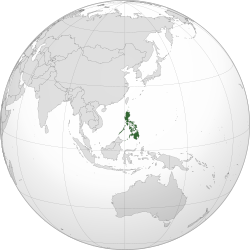फिलिपींस
Appearance
निर्देशांक: 13°N 122°E / 13°N 122°E
रिपब्लिक ऑफ़ दि फिलिपीन्स | |
|---|---|
 | |
| राजधानी | मनीलाa 14°35′N 120°58′E / 14.583°N 120.967°E |
| सभसे बड़ शहर | Quezon City 14°38′N 121°02′E / 14.633°N 121.033°E |
| सरकार | यूनिटरी प्रेसिडेंसियल संबैधानिक रिपब्लिक |
| रकबा | |
• कुल | 300,000[1][2] किमी2 (120,000 वर्ग मील) (72वाँ) |
• जल (%) | 0.61[3] (inland waters) |
• जमीनी | 300,000 |
| जनसंख्या | |
• 2015 जनगणना | 100,981,437[4] (13th) |
• Density | 336/किमी2 (870.2/वर्ग मील) (47th) |
| जीडीपी (पीपीपी) | 2018 अनुमान |
• कुल | $960.7 billion[5] (27th) |
• प्रति ब्यक्ति | $9,862[5] (119th) |
| जीडीपी (नॉमिनल) | 2018 अनुमान |
• कुल | $371.8 बिलियन[5] (36th) |
• Per capita | $3,430[5] (125th) |
| गिनी (2015) | medium · 44th |
| एचडीआइ (2017) | medium · 113th |
| करेंसी | पेसो (₱) (PHP) |
| टाइम जोन | PST (यूटीसी+8) |
| तारीख प्रारूप |
|
| ड्राइविंग | right[8] |
| कालिंग कोड | +63 |
| इंटरनेट टीएलडी | .ph |
| |
फिलीपींस (अंग्रेजी: Philippines) दक्खिन पूर्ब एशिया में एगो देश बाटे।
संदर्भ
[संपादन करीं]- ↑ "Philippine Population Density (Based on the 2015 Census of Population". September 1, 2016.
- ↑ "World Development Indicators - DataBank". databank.worldbank.org.
- ↑ "East & Southeast Asia :: Philippines". The World Factbook. Washington, D.C.: Author: Central Intelligence Agency. October 28, 2009. Archived from the original on July 19, 2015. Retrieved November 7, 2009.
- ↑ "Highlights of the Philippine Population 2015 Census of Population - Philippine Statistics Authority". www.psa.gov.ph. Archived from the original on 2017-02-02. Retrieved 2019-01-01.
- ↑ 5.0 5.1 5.2 5.3 "Report for Selected Countries and Subjects". www.imf.org.
- ↑ "Gini Index". World Bank. Retrieved 2 मार्च 2011.
- ↑ "Human Development Indices and Indicators: 2018 Statistical update" (PDF). United Nations Development Programme. 15 September 2018. Retrieved 15 September 2018.
- ↑ Lucas, Brian (2005). "Which side of the road do they drive on?". Retrieved 22 फरवरी 2009.
- ↑ "Presidential Decree No. 940, s. 1976". Manila: Malacanang. Archived from the original on May 29, 1976. Retrieved April 4, 2015.
{{cite web}}: Unknown parameter|dead-url=ignored (help) - ↑ "The Filipino Sign Language Act". Article 3, Republic act No. 11106 of Error: the
dateoryearparameters are either empty or in an invalid format, please use a valid year foryear, and use DMY, MDY, MY, or Y date formats fordate(PDF). Official Gazette. Government of the Philippines. Archived जुलाई 9, 2021 at the Wayback Machine - ↑ Genalyn Kabiling (12 November 2018). "Filipino Sign Language declared as nat'l sign language of Filipino deaf". Manila Bulletin. Archived from the original on 20 November 2018. Retrieved 12 November 2018.
- ↑ उद्धरण खराबी:Invalid
<ref>tag; no text was provided for refs namedOfficialLang - ↑ Treaty of General Relations Between the United States of America and the Republic of the Philippines. Signed at Manila, on 4 July 1946 (PDF), United Nations, archived from the original (PDF) on July 23, 2011, retrieved December 10, 2007
- ↑ "Republic of the Philippines Independence Day". United States State Department. Archived from the original on September 15, 2015. Retrieved July 30, 2015.
{{cite web}}: Unknown parameter|dead-url=ignored (help) - ↑ Calderón, Felipe (1907). Mis memorias sobre la revolución filipina: Segunda etapa, (1898 á 1901). Manila: Imp. de El Renacimiento. pp. 234, 235, appendix, pp. 5–10.
- ↑ Dolan, Ronald E. (1983). Philippines, a country study (4th ed.). Washington, D.C.: Federal Research Division, Library of Congress. ISBN 978-0-8444-0748-7.
| ई एशिया के अस्थान या भूगोल से संबंधित लेख एगो आधार बाटे। जानकारी जोड़ के एकरा के बढ़ावे में विकिपीडिया के मदद करीं। |




